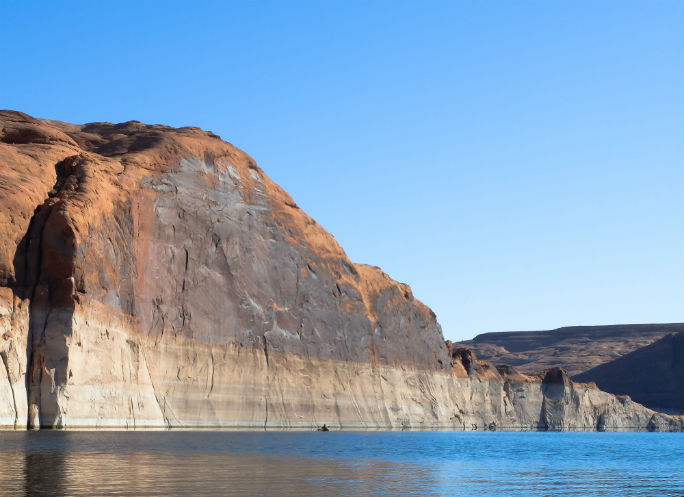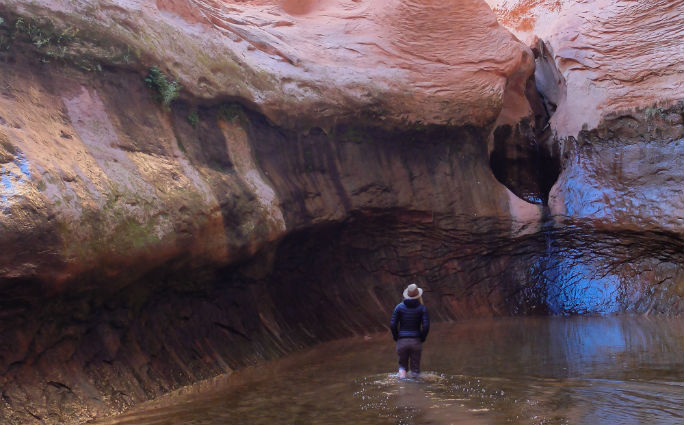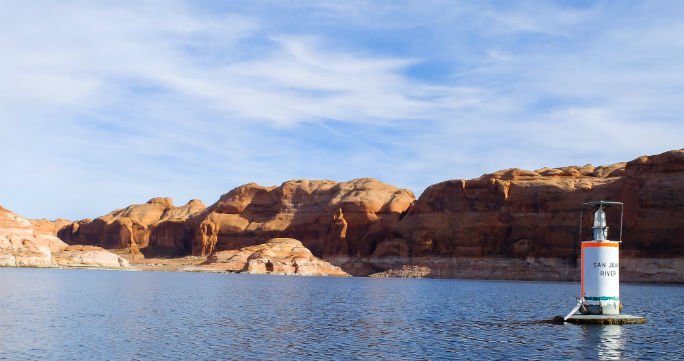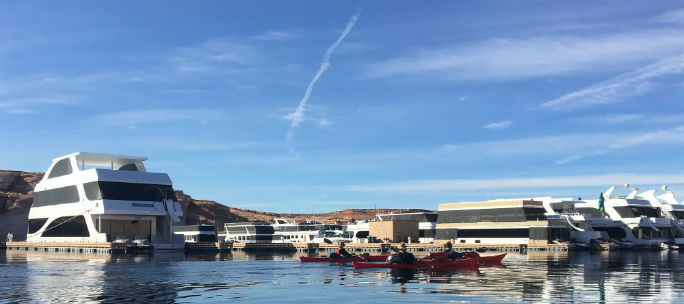My throat tightened first, then mist filled my eyes, clouding my vision. Soon, the first drop trickled down the crease of my nose, then a second. What’s wrong with me — this place is stunning — why get all emotional? As my gaze traced a path up towering sandstone cliffs streaked with black stripes, reaching into the bright cyan sky then plunging down into the water, the torrent from my eyes was unstoppable. Visions of my grandmother, aunt, and stepmom and dad all streamed through my mind, a desert flash flood of emotion.

Struggling to compose myself, I realized I was not alone. I had been paddling off the front of the group, lost in my thoughts, pushing and pulling with purpose. Sitting silently, I realized I had company. Catching a spark from Brendan’s camera lens focused on me and cocked in front of him, Kalen waited silently in her blaze red kayak, looking a bit bewildered as my heart lie open. What was causing this unexpected reaction from the guy who thought of paddling 87 miles down Lake Powell in winter? The trip leader was sobbing before the entrance to Cathedral in the Desert.
After two days on the water and three nights in frosty mummy bags, our dining, sleeping, and heat management systems were dialed with our own unique rhythms. Sunny spirits and upbeat flips of the paddle slid us through the glass-smooth waters of this vast reservoir. As we wound between red bluffs, bases ringed by an unbroken 50-foot high white band, the mystery of what we would find fogged our minds like a greasy haze across your sunglasses — opaque enough to see where you’re going, but obscuring the detail of towering walls, indigo water, and the bright winter sky.

Though none of us had ventured here before, each felt the gravity of our destination. Is this the right side canyon? Do I veer right or left at that bluff? These walls all look the same as I lead us forward. Brendan’s GPS confirmed the right track, and as we passed the somber, white buoy with the peeling words “Clear Creek” on the side, a sense of relief– this was the right spot. Ten more minutes and we would reach the day’s goal. Realizing this, my emotions took over.
Six months ago, I floated an idea of paddling sea kayaks through Lake Powell from Hall’s Crossing, Utah to Page, Arizona. 87 “river” miles north to south — from buoy 93, past the confluence of the Escalante River at mile 68, then the San Juan at mile 57. Past Dangling Rope at mile 43, then another 37 miles to Antelope Point at mile six, over nine days. In early December, average daytime highs are 41 degrees, and nights dip into the low 20s. Daylight too is fleeting, and we would need to make at least 12 miles a day, although a moderate wind could bring our little boats to a standstill if breathing up-lake. Most people come to Lake Powell to drink beer and play in the desert sun on motorized toys, not physically work for it.
I struggled to stop thinking of this place as the Colorado River, even as river-like signs were everywhere. Towering Navajo and Wingate sandstone, meandering canyons, dry desert air and dusty bighorns. Driftwood. This was a lake where a river used to flow — one of massive breadth, temporarily housing billions of gallons of the most precious resource in the southwest on its path from high mountain creeks of the Colorado River, through the Grand Canyon and western Arizona, on to the salad fields of Barstow, or Tijuana.

I wanted to explore what author Kevin Fedarko has coined “the most haunted landscape in America,” and certainly one of the most confounding collisions of spectacular, natural wonder and the mind-bending power of man’s technological influence. I wanted to explore a place so overlooked by outdoor enthusiasts and adventurers, and despised by those who cherish wild, natural landscapes. I wanted to explore a place representing such vile and greedy human meddling, but providing a lifestyle for millions of people across the southwest that is extraordinarily complex and widely misunderstood. I wanted to explore a place that had been so integral to three generations of my family.
I wanted to traverse the graveyard, headstones of artifacts lost I grew up gazing at in Sierra Club photo books and through the words of Brower, Stegner, Reisner, and Abbey. The 30 miles of lake flanking the confluence with the San Juan are where treasures like Hidden Canyon and Music Temple, Iceberg and Cascade Canyons, Grotto Canyon (site of Katie Lee’s famous swimsuit photo) and yes, Cathedral in the Desert, lie submerged. The collection of Eleanor Inskip’s stories, contained within Glen Canyon Before Lake Powell, would serve as our inspiration and guide down this equally loved and despised landscape.
My grandmother loved Glen Canyon, and raced creeping waters to witness archeological treasures whose death sentences were mere days or weeks away. My aunt was on some of the final river trips through Glen Canyon, beside people in the desperate fight to stop the construction of the dam with public outreach, outcry, and outrage. My Dad spoke out; leading high school students into the canyons in 1965, exposing them to what would be lost. My Stepmom wrote and mourned the river’s death, driving a family priority to get us out into these landscapes, entrenching in us the values and beauty of natural places. These influences cast my mold as a life-long preservationist, who now spends each day begging an apathetic public to speak up for the last remaining places before they disappear. Glen Canyon was drowned before I was born, and this is likely the only way I ever will see it.

I had to go, but needed help. Photographer Forest Woodward was in. Writers Brendan Leonard and Hilary Oliver were in, as was Kalen Thorien, pro skier and adventurer.
Miles passed quickly as we strung out across the expansive lake. Paddling with quick strokes, I took the lead with a mapped destination to achieve. Kalen felt out her kayak, adjusting to a different kind of liquidity from the frozen crystals she normally shreds. Brendan and Hilary chatted along, gazing at a starkly different landscape from what they normally pursue in Norway, Switzerland, or Denver. Shutters clicked as Forest absorbed and captured colorful light. Following a quick lunch at Lake Canyon, we pressed on to camp near Elephant Arch at mile 83. We pulled off 10 miles getting used to the scene, but around 4:30 as the sun dashed for an exit in the western sky, we quickly realized that setting up this first camp would be cold and dark. Campfire-ninja Forest made swift work of gathering sticks and lighting a small blaze, casting light and warmth over our little pocket of sandstone, sand, and blanket of stars.
Sunrise — Powdered coffee with powdered milk, oatmeal, hurried packing, back on the water. In Iceberg Canyon, a 20-foot tall flake of bleached sandstone had chipped off from what is now the “bathtub ring” left by declining lake levels, revealing swirled streaks of rust from the raw rock beneath. What did this canyon look like prior to 1963, and how would it claw its way back to natural glory? Paddling toward Longs Canyon — through a long, dead-straight avenue of canyon walls reinforced just how massive the lake is — especially considering the hundreds of feet of water directly below. The Colorado River would have been winding and sinuous, but the tops of these walls reveal a straight course, with the meanders and sensual curves flooded beneath us.
Yet, unexpected discoveries still reveal themselves, as was proven at Longs Canyon. Scouting ahead for anything interesting, I traversed from a left side canyon to the right. Kalen and Hilary chose to simply paddle deep into the left slot, and as I waited for them to emerge, I heard calls of “waterfall back here…come see!” I had written off that slot as a dead end — but rounding the corner to join them I saw the small cascade of water rushing from a pour-over, splashing into still waters. Natural wonders hiding patiently, even in a most altered landscape.

Minutes before sunset we arrived at a sandy camp at the confluence with the Escalante River near mile 69, ahead of schedule after busting out 25 miles over two crisp days. Cooking ramen in the dark, the locals came to join us — scurrying mice challenging our food storage. Boldly, one got a bit too close, and without even noticing the little guy underfoot, I squished him to an untimely end.
The biggest prize of the trip, Cathedral in the Desert, awaited us and we decided to take advantage of our progress and spend extra time exploring this Glen Canyon treasure. From the mouth of the Escalante we would push upstream another two miles to Clear Creek, then paddle up from there. None of us knew what we would find, but as the canyon walls closed tighter over our heads, we humbly gave this place the time and respect it deserves. I led the way, and after feeling such raw sorrow and regret for this beauty being taken from me, my perspective changed to one of appreciation and gratitude. There is still beauty left to absorb here.

I pulled my kayak into a narrow slot in the sandstone, lifting it out of the way so the group could make landfall. Kalen came next, then the others. She and I strode silently a few hundred feet, meandering between towering canyon walls completely blocking the sky from the cool, moist cavern of wet sand, trickling water, ferns and tiny plants clinging to life in the seeps weeping from the rusty walls. Rounding the final corner revealed a quiet pool, fed by a trickling stream no more than eight-inches across, only splashing drops and the pads of our footsteps breaking the silence. This is what remains of the Cathedral, the soul within the rock, and as we stood there with tears wetting our faces, we felt the canyons heart pulse. Life surrounds it, and while much of the neighborhood may be gone, the spiritual core of Glen Canyon still exists, waiting to thrive again. Taking turns wading across the pool, dipping our hands into the gentle force of the falls, I knew we had arrived at a solemn, stoic, and serene place.
I never thought I would stand here, but here I was, absorbing her magic, humbled by her resilience and grace.

Kalen rolled up her pant legs and walked gingerly into the pool to pay homage to the spirit and life we had found in this hidden gorge. Running her hands through the trickling falls, taking a handful to drink and dotting her face with this water was like accepting a sacred gift. One that was alive and available to those open and accepting of her offering.
Gliding toward the main channel, a sense of relief washed over me that, while tucked away and certainly not abundant, life still clings to this place. In the distance I overheard Hilary forcefully say “I hadn’t really felt any anger about this place until now. Now, I am really f-ing angry!” She had envisioned some of her most special places, imagining them flooded or washed away. Paddling in silence, each of us digested the meaning of what we had experienced, and how to put it into place in our own lives. Seeking the night’s camp, a somber shroud draped over us as we pondered what remained of the long trip ahead.
As a younger man, I rafted the San Juan numerous times from Mexican Hat to Clay Hills Crossing. While most of those trips required a long row from Grand Gulch to the take out on a tentacle of Lake Powell, from the mouth the “river” was eerily unfamiliar. Paddling out to the San Juan River buoy to verify the end of the channel I knew so well, it hit me — the lake changes everything.

Our camp opposite Twilight Canyon was sandy, protected, and delightful, even after the discovery of a long-dead male desert bighorn lying mummified on the beach. “He could have drowned, maybe even fallen off this cliff into the water,” Brendan suggested. “Bob’s” mouth stretched as if releasing a desperate scream for another breath. After paying our respects, camp conversations were light and lively, reliving days past and trading life goals and future trips. The group had settled together and found our rhythm, the Millennials setting off to explore our surroundings, while the older crowd set up tents and filtered water, poked the fire, and stretched our tired shoulders. We huddled by the warmth, scribbling in our journals — Brendan donning headphones, Hilary and I gazing into glowing embers — sorting our impressions of the day. Scribble. Gaze. Repeat.
Descending mileage markers logged more discoveries, each one new and unique. Narrow slots ending in passageways stuffed with drifted logs, some no wider than a paddle tip halted a side-excursion. Quick trips in pursuit of a famous photo, such as Grotto Canyon where Katie Lee famously clung inside a curving, sculpted cavern ended with comments like “I think your Grotto is a hundred feet below us.” My enthusiasm sunk realizing a precious and spectacular landmark we picked from Glen Canyon Before Lake Powell lie deep below our boats. Each night, brilliant evening fireworks, painted in bright watercolors, nudged us into sleeping bags as Orion rose and the Milky Way pierced the black sky.

Canyon walls morphed from towering overhead to merely rolling alongside, escorting us towards Antelope Point. We slowed our pace as urgency to make time eased and we savored the remaining miles on the lake. Scouring random inlets for driftwood became a game of hide-and-seek. This trip had come together as a loose collection of individuals, but as the sun cleared the streaked walls one last time, we paddled in tight formation, chatting happily about future adventures. Would we come back together in spring to complete the traverse of the lake — paddling the 40-mile stretch from Hite to Halls Crossing — child’s play compared to what we had accomplished? Would we experience the flip side of our adventure and rent a houseboat and jet skis for some spring-break style debauchery? The outlook for another adventure cast excitement and anticipation.
The trip framed so many parts of who I have become over the years. From my love of the desert, of canyons, of the wild outdoors, Lake Powell certainly provided much to fuel that part of who I am. It also unexpectedly spoke to my family ties, and how important the past two generations of Eberle’s have been to cultivate the place where my life is today. And lastly, how important it is to remain vigilant against the narrow minded and arrogant, who merely want to rework nature for their own comfort, ignoring the impact actions have on places, once gone, we can never replace. Generations will never see Glen Canyon as it was — as Wallace Stegner wrote “In gaining the lovely and the usable, we have given up the incomparable.” As I said goodbye to the Cathedral in the Desert, paddling along with my friends in this altered presentation of wilderness, my resolve and diligence to preserve these places is renewed. While not my goal when I first conceived the trip, perspectives like this can only be gained by experiencing these landscapes, pristine or not.

Editor’s note: Guest Contributor Sinjin Eberle is the Communications Director/Executive Producer at American Rivers. He is a writer, photographer, executive producer of short films, and driver of communications and advocacy across the west. See the original article here published on Rides and Rivers where you can read more of Sinjin’s work.